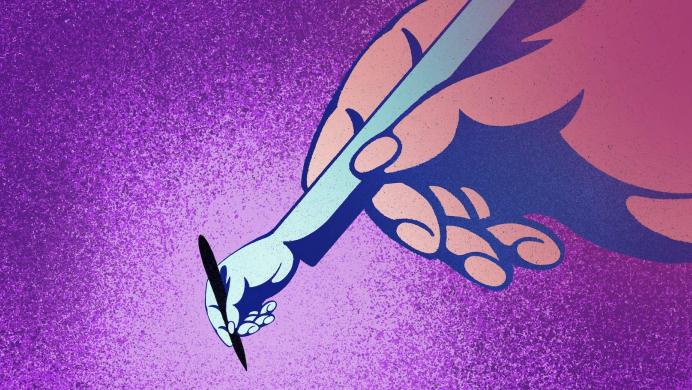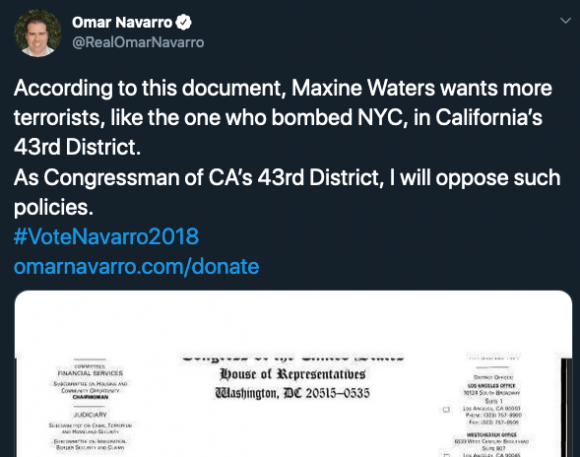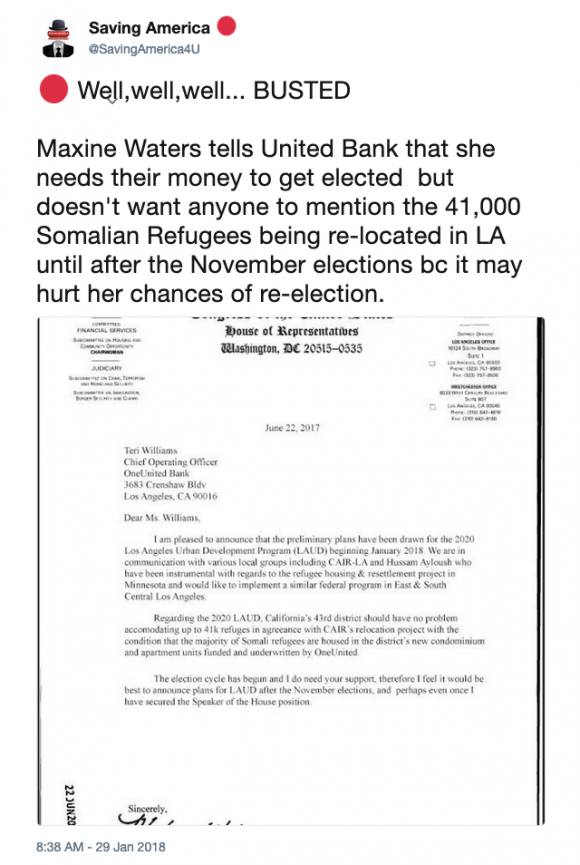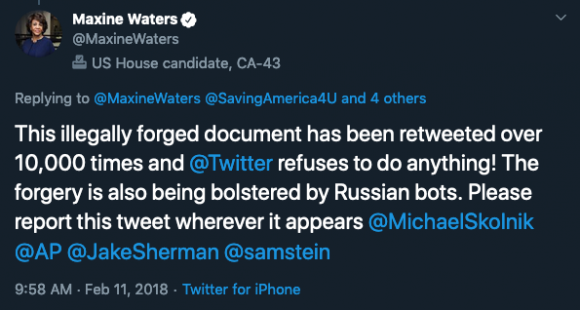

Forgery: The Maxine Waters Letter
Overview
In December 2017, congressional candidate Omar Navarro instigated a campaign to denigrate his political opponent, Congresswoman Maxine Waters. Exploiting and wedge issues via a forgery, his campaign was seeded by pseudonymous participants and right-wing online. After Waters formally challenged the harassment on Twitter, the campaign was amplified by mainstream press, and investigated by the FBI. Navarro has adjusted tactics to continue harassing Waters and other political opponents after his initial campaign failed to lead to his election.
STAGE 1: Manipulation Campaign Planning and Origins
Omar Navarro attempted a congressional run for California’s 43rd district in 2016 and 2018. Sitting congresswoman Maxine Waters was his political opponent in both races. For his 2018 campaign, Navarro drew support from an assortment of partisan, right-wing politicians, influencers, and strategists — particularly Herman Cain,1 Roger Stone, Laura Loomer, Joe Arpaio, and Alex Jones.2 During both the 2016 and 2018 campaign seasons, he repeatedly attempted to attract Waters’ attention using targeted harassment. He made wild accusations on social media3 and in right wing press,4 and even live-streamed public protests outside her home.5 In December 2017, Navarro instigated a media manipulation campaign to denigrate Waters. Exploiting prejudice and wedge issues via a , this campaign was seeded by pseudonymous participants and right-wing influencers online.
On December 11, 2017, Navarro tweeted the following: “Maxine Waters wants more terrorists, like the one who bombed NYC, in California’s 43rd District. As Congressman of CA’s 43rd District, I will oppose such policies. #VoteNavarro2018.”6 The tweet included an image of a low-resolution scanned letter. This false and inflammatory letter appeared to detail a plan by the congresswoman and the Council for American-Islamic Relations (CAIR) to garner a donation from OneUnited Bank to relocate 41,000 Somali refugees to her district. While Navarro made no claim as to the letter’s authenticity, he also provided no solid information on where it was sourced,7 indicating only that it was provided to his campaign via .8
This letter, a forgery, exploited multiple social vulnerabilities and racial prejudices. Water’s connection to OneUnited, the largest Black-owned bank in the United States and the subject of several controversies,9 as has the bank itself since 2008.10 In 2012, Waters was cleared of violating House ethics rules in her dealings with the bank,11 though the accusations have continued to be mobilized against her by political opponents since. This forgery shared by Navarro, and filled with easily identified factual errors, attempted not only to rekindle those OneUnited Bank accusations, but compound them by suggesting Waters was purposefully working with Muslim organizations to resettle Muslim refugees to the 43rd district. Immigration is a long-standing in California politics,12 as is Islamophobia.13
- 1Adelle Nazarian, “EXCLUSIVE – Herman Cain Endorses Maxine Waters’ Conservative Latino Challenger Omar Navarro,” Breitbart, September 16, 2017, https://www.breitbart.com/local/2017/09/16/exclusive-herman-cain-endorses-maxine-waters-conservative-latino-challenger-omar-navarro/.
- 2Sarah D. Wire, “Why conservative headliners are teaming up to challenge Maxine Waters in Los Angeles,” The Los Angeles Times, November 27, 2017, https://www.latimes.com/politics/la-pol-ca-waters-gop-challenger-20171027-story.html.
- 3Omar Navarro (@RealOmarNavarro), “Maxine Waters why aren’t you looked into the 13 other homes you own…,” , December 10, 2017, https://twitter.com/RealOmarNavarro/status/940068588760711169.
- 4Joshua Kaplan, “TGP EXCLUSIVE: GOP Challenger Omar Navarro Calls Out Maxine Waters For Interfering in Haitian Elections,” The Gateway Pundit, July 23, 2017, https://www.thegatewaypundit.com/2017/07/tgp-exclusive-gop-challenger-omar-navarro-calls-maxine-waters-interfering-haitian-elections/.
- 5Omar Navarro, “Omar Navarro Announcement with supporters outside the home of Rep. Maxine Waters,” , May 23, 2017, https://youtu.be/I1peST-j1C4.
- 6Omar Navarro (@RealOmarNavarro), “According to this document, Maxine Waters wants more terrorists, like the one who bombed NYC, in California’s 43rd District…,” Twitter, December 11, 2017, http://archive.is/FdTtj.
- 7Omar Navarro, “According to a source Maxine Waters sent a complaint to the U.S. Attorney about a document I shared on Twitter,” Periscope, December 14, 2017, https://www.pscp.tv/w/1yoKMMMYnkwKQ.
- 8Sarah D. Wire, “Rep. Maxine Waters asks Justice Department to investigate fake letter tweeted by Republican opponent,” The Los Angeles Times, December 14, 2017, https://www.latimes.com/politics/essential/la-pol-ca-essential-politics-updates-201711-htmlstory.html#rep-maxine-waters-asks-justice-department-to-investigate-fake-letter-tweeted-by-republican-opponent.
- 9Beth Healy, “Church, OneUnited wage bitter loan fight,” Boston.com, October 24, 2010, http://archive.boston.com/business/articles/2010/10/24/church_oneunited_wage_bitter_loan_fight/; Jessica Van Sack, “Hub bank honcho’s checkered past includes sex-assault and coke charges,” The Boston Herald, August 12, 2010, https://www.bostonherald.com/2010/08/12/hub-bank-honchos-checkered-past-includes-sex-assault-and-coke-charges/.
- 10Susan Crabtree, “Bank at center of Waters controversy got $12 million bailout despite reviews,” The Hill, September, 15, 2010, https://thehill.com/homenews/house/119099-bank-at-center-of-waters-controversy-got-12m-bailout.
- 11Rosalind S. Helderman, “California Rep. Waters cleared of ethics charges,” The Washington Post, September 21, 2012, https://www.washingtonpost.com/blogs/2chambers/post/california-rep-waters-cleared-of-ethics-charges/2012/09/21/75d346c2-03f3-11e2-8102-ebee9c66e190_blog.html.
- 12“CA's Anti-Immigrant Proposition 187 is Voided, Ending State's Five-Year Battle with ACLU, Rights Groups,” ACLU, July 29, 1999, https://www.aclu.org/press-releases/cas-anti-immigrant-proposition-187-voided-ending-states-five-year-battle-aclu-rights.
- 13“2018 CAIR-CA Civil Rights ,” The Council on American-Islamic Relations California (CAIR-CA), accessed on August 11, 2020, https://ca.cair.com/sacval/publications/2018-cair-ca-civil-rights-report/; Hatem Bazian, “Islamophobia: An Electoral Wedge Issue!” The Berkeley Blog, February 25, 2015, https://blogs.berkeley.edu/2015/02/25/islamophobia-an-electoral-wedge-issue/.
STAGE 2: Seeding Campaign Across Social Platforms and Web
Despite Navarro’s appearance on Infowars promoting the forgery on December 22,1 the document did not get much attention on his own account initially. It did not spread widely until after people on social media, image boards, and undertook a seeding campaign to amplify it in January, 2018. In late January, the forgery was posted to 8chan in a now-deleted thread. On January 28, the Hal Turner Radio Show show published an article with a screenshot of the letter, containing a URL indicating the image was originally hosted on .2 The same day, a user posted the same 8chan-sourced screenshot in a thread on .3 It was simultaneously posted to Reddit’s the_donald.4 These coordinated posts on sites used for right-wing political organizing accelerated its spread on social media.
On January 29, 2018, Twitter user @SavingAmerica4U shared a screenshot of the letter, which also contained the 8chan URL.5 Later that day, a screenshot of this tweet was uploaded to Imgur,6 and the YouTube account Smile Wild reproduced the Hal Turner article in a video.7 Another 4chan post containing a screenshot of the letter also appeared on January 29, this one without the 8chan URL.8 Variants of the image were also shared by networked factions on Twitter and Facebook, including accounts associated with the QAnon community.
Subsequently, several small right-wing blogs and reposted the news from social media.9 The seeding campaign reached a peak on February 11 when conservative influencer Terrance K Williams shared the letter, without the 8chan watermark and including legitimate screenshots of negative reactions from Waters’ Twitter account.10 The tweet received significant interactions and helped to further muddy the waters concerning the 's legitimacy.
Although it appears that most people understood the letter was forged, there is some evidence that the document muddied the waters regarding the alleged donation to the Congresswoman. Individuals online believed it was real,11 forcing Waters to call for both its removal and an investigation by the FBI.
- 1Omar Navarro, “Deranged Maxine Waters Claims Cubans Aren't Latino,” YouTube, December 21, 2017, https://www.youtube.com/watch?v=WFcTFWBvLrs.
- 2“Maxine Waters Arranging 41,000 Somali Refugees for South, Central Los Angeles - in Secret - with CAIR,” The Hal Turner Radio Show, January 28, 2018, https://archive.is/vxefO.
- 3Anonymous, “/pol/ - Politically Incorrect » Thread #158375413,” 4chan, January 28, 2018, accessed via 4plebs, https://archive.4plebs.org/pol/thread/158375413/#158375413.
- 4u/Vernon_Mansae, “BREAKING NEWS: Maxine Waters Arranging 41,000 Somali Refugees for South, Central Los Angeles - in Secret - with CAIR,” r/thedonald, , January 30, 2018, http://archive.is/pjsp4.
- 5@SavingAmerica4U, “Well,well,well... BUSTED Maxine Waters tells United Bank that she needs their money to get elected...” Twitter, January, 29, 2018, http://archive.is/uV7mP.
- 6“Aunt Maxine is going to bring 41,000 Somalians to LA but not till after November so don't tell anyone cuz that would be bad,” Imgur, February 11, 2018, https://imgur.com/ow1x3ND.
- 7Wild Smile, “Maxine Waters To Bring In 41,000 Somali Refugees To California Illegally,” YouTube, January 29, 2018, https://www.youtube.com/watch?v=yLl7abm6OlQ.
- 8Anonymous, “/pol/ - Politically Incorrect » Thread #158427802,” 4chan, January 29, 2018, accessed via 4plebs, https://archive.4plebs.org/pol/thread/158427802/#158427802.
- 9JM Talboo, “Maxine Waters To Bring In 41,000 Somali Refugees To California Illegally - Diamond and Silk go off on Maxine and Lewis for not attending the SOTU,” Trump Is Right (blog), January 31, 2018, https://trumpisright.blogspot.com/2018/01/maxine-waters-to-bring-in-41000-somali.html; Emma Laftchu, ““Fake Letter” Posted By Political Opponent, Rep Waters Says She Reported,” RWC News, January 30, 2018, https://rwcnews.com/fake-letter-posted-by-political-opponent-rep-waters-says-she-reported.html.
- 10Terrence K. Williams (@w_terrence), “Mad Maxine Waters is working hard to get this letter removed from twitter...,” Twitter, February 11, 2018, https://archive.is/k1iMu.
- 11❌🎰SOPHIA-ESTRADA PEREZ❤💋🎲💙 (@SophiaEstradaP6), “@RealOmarNavarro Wow! Omar, EVERYONE in Your DISTRICT Must See This. There’s so Many AMERICAN LEGAL CITIZENS IN NEED & MAXINE WATERS Wants to BRING IN MORE! This Is so DISGUSTING on Her PART! This Must Be Spread to Everyone to See. Thank You for Posting This.🖒 #VoteNavarro2018 #ImpeachMaxine,” Twitter, December 11, 2017, https://twitter.com/SophiaEstradaP6/status/940335935140405248.
STAGE 3: Responses by Industry, Activists, Politicians, and Journalists
Maxine Waters responded to Navarro’s initial post of the forgery three days later. On December 14, she issued a statement on social media condemning the document.1 The Los Angeles Times published an article that day that debunked the letter as a forgery and included an interview with Navarro.2 Though the article was critical, Navarro made clear he considered the increased media exposure a success. In a YouTube video titled “Merry Christmas - We Got Maxine Waters Attention,” Navarro claimed a small victory.3
There was a secondary spike of attention on February 11, 2018, when Waters again reacted by publicly recognizing the forged document with the 8chan URL shared by @SavingAmerica4U and requesting that Twitter remove it. “This illegally forced document has been retweeted over 10,000 times,” Waters wrote. “This letter was first released by Rep. Waters’ opponent. It’s now being pushed by the alt Right & Russian . I’ve reported this to the @FBI Please report!”4 Influential behavioral scientist Caroline Orr, who tweets under the handle RVAwonk, pointed out the 8chan URL visible on the screenshot of the forgery.5 Replying to RVAwonk, Waters reached out to Twitter support, journalists, and groups on Twitter, amplifying the forgery further.6
The Los Angeles Times as well as other prominent media outlets extensively covered Waters’ subsequent tweets calling for an FBI and Justice Department investigation into the matter.7 As of June, 2020, Waters’ related tweets have collectively generated more than 13,000 likes and 8,000 retweets, far more than any single post by users sharing the forgery. Despite the negative attention for the forgery, conservative news outlets such as Fox News featured Navarro as a guest for the remainder of his campaign.8 In addition, on March 16, 2018, former National Security Advisor Michael Flynn formally endorsed Navarro at a campaign event.9
- 1Maxine Waters (@RepMaxineWaters), “Yesterday, I registered a complaint w/ the House Office of General Counsel against Omar Navarro for misrepresenting my DC office...,” Twitter, December 17, 2017, https://twitter.com/RepMaxineWaters/status/941695984567975936.
- 2Wire, “Rep. Maxine Waters asks Justice Department to investigate fake letter tweeted by Republican opponent.”
- 3Omar Navarro, “Merry Christmas - We Got Maxine Waters Attention,” YouTube, December 25, 2017, https://www.youtube.com/watch?v=5XPioTmU9yY.
- 4Maxine Waters (@RepMaxineWaters), “This illegally forged document has been retweeted over 10,000 times and @Twitter refuses to do anything!…,” Twitter, February 11, 20918, https://twitter.com/maxinewaters/status/962702350094946304.
- 5Caroline Orr (@RVAwonk), “This website, which is a frequent source of , made the mistake of putting its watermark on a forged document…,” Twitter, February 13, 2018, https://twitter.com/RVAwonk/status/963404165279047682.
- 6Maxine Waters (RepMaxineWaters), “.@Jacob__Siegel @VICE @vicenews Please take a look at this thread. This forged document appears to link back to Hal Turner and 8chan...,” Twitter, February 13, 2018, https://twitter.com/MaxineWaters/status/963556206034944003.
- 7Sarah D. Wire, “FBI to talk to Rep. Maxine Waters’ opponent about tweeting of fake letter,” The Los Angeles Times, August 27, 2018, https://www.latimes.com/politics/la-na-pol-waters-fbi-letter-20180827-story.html.
- 8Omar Navarro, “Omar Navarro Interview with Fox & Friends,” YouTube of Fox News segment, October 15, 2018, https://www.youtube.com/watch?v=wSuAyLtNIP0.
- 9Sophie Tatum, “Michael Flynn endorses California congressional candidate,” CNN, March 17, 2018, https://www.cnn.com/2018/03/16/politics/michael-flynn-campaigning-california/index.html.
STAGE 4:
On August 11, 2018, Navarro announced on Twitter that the FBI was investigating his post,1 a fact later confirmed by the LA Times.2 No charges were pressed at that time. Though @SavingAmerica4U’s original tweet remained on Twitter for over a year, it appears to have been removed as of June, 2020, long after Waters’ calls to action. Tweets from many other Twitter users, including Terrance K Williams, remain online. The manipulation campaign was ultimately ineffective, as Waters easily defeated Navarro in the congressional race, receiving almost 78% of the vote.3
STAGE 5: Adjustments by Manipulators to New Environment
In June, 2020, Navarro was released from a six-month jail sentence for the crime of stalking an ex-girlfriend, and immediately registered to run for Waters’ seat again in 2022.4 He then began harassing not only the congresswoman but also her 2020 Republican opponent Joe Collins, adjusting his tactics, but employing similar smear tactics as he used against Waters in 2018.5 Right-wing Twitter personality Candace Owens then increased the visibility of the anti-Waters campaign further, by retweeting statements disparaging both Waters and Collins.6 Despite the failure of his forgery campaign to win votes in 2018, Navarro’s inflammatory rhetoric and continues to gain attention for his political campaign from right wing influencers online.
- 1Omar Navarro (@RealOmarNavarro), “Let’s get this straight I tweet a letter which says Maxine Waters wants to bring 41,000 Somali refugees…,” Twitter, August 27, 2018, https://twitter.com/RealOmarNavarro/status/1034132291499356160.
- 2Wire, “FBI to talk to Rep. Maxine Waters’ opponent about tweeting of fake letter.”
- 3Michael Burke, “Maxine Waters reelected to House seat in California,” The Hill, November 7, 2018, https://thehill.com/homenews/house/415421-maxine-waters-reelected-to-house-seat.
- 4Will Sommer, “Maxine Waters Foe Omar Navarro Gets Out of Jail And Attempts to Destroy Fellow Republican,” The Daily Beast, January 9, 2020, https://www.thedailybeast.com/california-rep-maxine-waters-foe-omar-navarro-gets-out-of-jail-and-attempts-to-destroy-fellow-republican.
- 5Omar Navarro (@RealOmarNavarro), “Since Maxine Waters' new fake Republican opponent Joe Collins attacked @RealCandaceO and @TheOfficerTatum, here's the truth about him...” Twitter, July 1, 2020, https://twitter.com/RealOmarNavarro/status/1278452947676999680.
- 6Candace Owens (RealCandaceO), “Republicans can be so desperate for minority allies, that they mistakenly get behind people…,” Twitter, July 1, 2020, https://twitter.com/RealCandaceO/status/1278474834960437249.
Cite this case study
Joan Donovan and Brian Friedberg, "Forgery: The Maxine Waters Letter," The Media Manipulation Case Book, July 7, 2021, https://casebook-static.pages.dev/case-studies/forgery-maxine-waters-letter.



